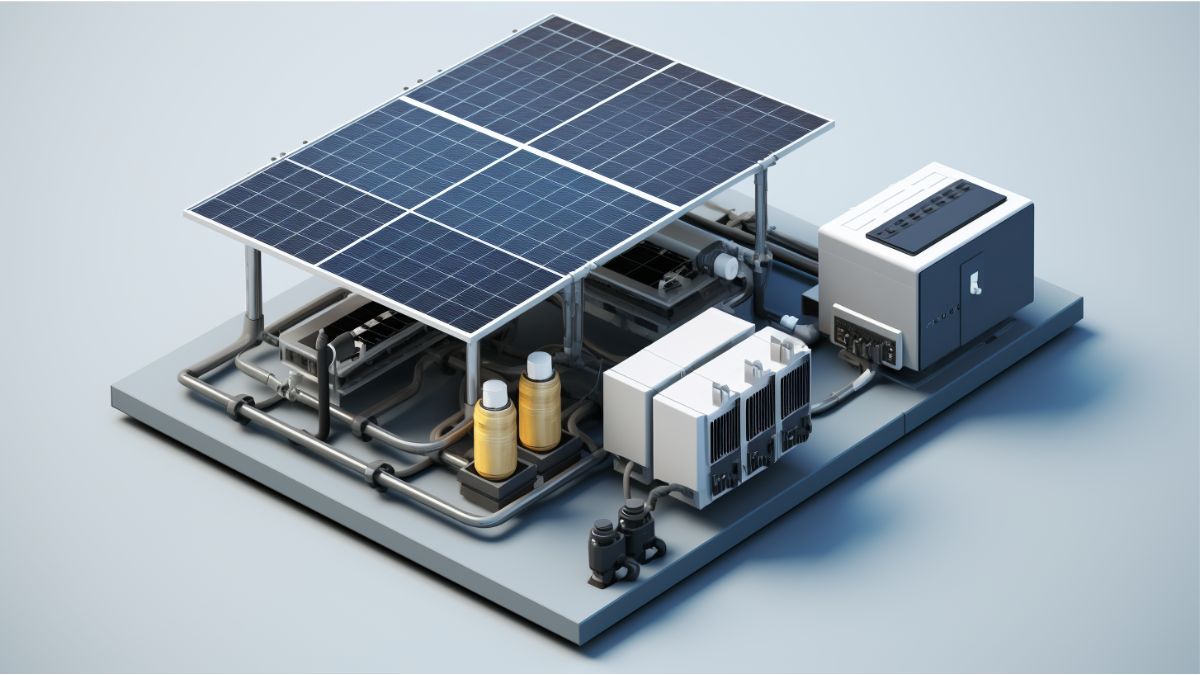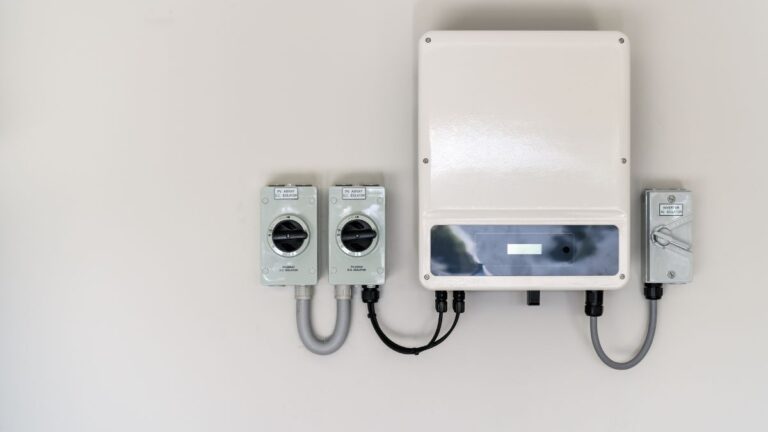Integrating Solar Battery To Your Energy System As Retrofit
Did you know that integrating a backup battery into your existing solar panel system can provide you with a reliable source of energy even when the sun isn’t shining? It’s true! Integrating solar battery to your system allows you to store excess energy generated by your solar panels for use during cloudy days or at night.
In this article, we will explore the process of retrofitting a solar battery to your energy system, the benefits it can bring, and how to find the right installer for this upgrade. So let’s dive in and discover how you can enhance your solar power system with a battery!
Key Takeaways
- Adding a backup battery to your solar panel system can be difficult depending on whether your system was designed for energy storage.
- AC coupled solutions allow you to keep your existing solar inverter but result in some efficiency loss over time.
- Inverter replacement/DC coupled solutions result in a more efficient system with less energy loss during conversion but can be more expensive upfront.
- Most solar batteries designed for small-scale use are compatible with existing solar panel systems, but stacking multiple batteries may be necessary for extended off-grid use.
How to Add a Battery to a Solar Energy System
To add a battery to your solar energy system, you have two options: AC coupled or inverter replacement.
When considering the battery capacity, it is important to choose a size that is suitable for your solar system. AC coupled systems offer flexibility in battery size selection, while inverter replacement allows for a more efficient system with less energy loss during conversion.
The battery lifespan depends on the type and quality of the battery, but proper battery maintenance can help prolong its life. Battery charging methods vary, with options for grid charging, solar charging, or a combination of both.
The battery backup duration will depend on the size of the battery and the amount of energy consumption during a power outage.
Related Post: AC Vs DC Solar Battery Coupling System: Which Is More Efficient?
Benefits of Adding a Battery to an Existing Solar Panel System
Adding a battery to your existing solar panel setup can provide you with backup power during outages and reduce your dependence on the grid. Not only does it offer backup power reliability, but it also brings numerous benefits to your energy system. Let’s take a closer look at the advantages of integrating solar battery into your existing solar panel system:
Performance Benefits
- Provides backup power during outages
- Stores excess solar energy for later use
- Helps balance energy supply and demand
Economic benefits
- Reduces electricity bills by utilizing stored solar energy
- Minimizes peak-time electricity rates
- Potential for selling excess energy back to the grid
Environmental impact
- Reduces reliance on fossil fuels
- Lowers carbon footprint by utilizing renewable energy
- Helps combat climate change
Long term savings
- Increases energy self-sufficiency
- Reduces dependence on the grid
- Potential for long-term cost savings
Backup power reliability
- Ensures uninterrupted power supply during emergencies
- Provides peace of mind knowing you have a backup power source
Compatibility of Solar Batteries With Your Panels
Most solar batteries designed for small-scale use can be easily paired with existing solar panel systems. When considering the compatibility of solar batteries with your panels, there are a few key factors to keep in mind:
- Battery capacity requirements: Determine your energy storage needs to select a battery with the appropriate capacity. Consider your average daily electricity consumption and any specific backup power requirements.
- Lifespan of solar batteries: Solar batteries typically have a lifespan of 10-15 years. Evaluate the warranty and lifespan of different battery models to ensure long-term reliability.
- Impact of battery retrofit on energy savings: Adding and integrating solar battery to your solar panel system can increase energy savings by storing excess electricity for later use. It allows you to maximize self-consumption and reduce reliance on the grid.
- Maintenance and monitoring of solar batteries: Regular maintenance and monitoring are essential to ensure optimal performance and longevity of your battery. Follow manufacturer guidelines and consider professional monitoring services for peace of mind.
- Financial incentives for battery retrofit: Depending on your location, there may be financial incentives available for adding and integrating solar battery to your solar panel system. Research local rebates, tax credits, and incentives to maximize the financial benefits of your retrofit project.
Installation Labor Cost for a Backup Battery
The installation labor cost for a backup battery can vary depending on the hourly rate of an electrician in your area. When considering the cost of adding a backup battery to your solar panel system, it’s important to take into account several factors.
The timeframe for installation is typically relatively short, as adding a battery is a relatively simple electrical project. However, if the inverter needs to be replaced as part of the installation, it may increase both the time and cost.
The impact on energy savings can be significant, as a backup battery allows you to store excess energy generated by your solar panels for use during times when the sun isn’t shining.
Maintenance requirements for a backup battery are generally minimal, with regular checks and occasional cleaning recommended. It’s also important to consider warranty coverage for the battery, as this can vary depending on the manufacturer and installer.
Related Article: Exploring the Best Battery Options for Whole Home Backup System.
Finding an Installer for Energy Storage
When considering energy storage, it’s important to find an installer who specializes in this service. Here are some key factors to consider when choosing an installer for your energy storage needs:
- Cost considerations: Look for an installer who can provide a competitive price for the installation of your battery system. Compare quotes from different installers to ensure you are getting the best value for your money.
- Warranty options: Check if the installer offers warranties on both the battery system and the installation work. A reputable installer should provide a warranty to protect your investment and provide peace of mind.
- Maintenance requirements: Inquire about the maintenance requirements of the battery system and whether the installer offers any maintenance services. Understanding the maintenance needs will help you plan for the long-term care of your energy storage system.
- Available incentives: Ask the installer about any available incentives or rebates for installing an energy storage system. These incentives can help offset the upfront cost of the installation and make the investment more affordable.
AC Coupled Solution for Battery Retrofit
Consider opting for an AC coupled solution if you want to keep your existing solar inverter and have flexibility in choosing the size of your battery relative to your solar system. AC coupled systems, although they result in some efficiency loss over time, offer the advantage of allowing you to integrate a battery with your current inverter. This means you don’t have to replace your inverter, saving you time and money.
However, it’s important to note that AC coupled systems have additional conversion steps, making them slightly less efficient than systems with a single inverter. When choosing the right battery for your retrofit, consider factors such as the desired storage capacity and the specific needs of your household.
Additionally, battery retrofits offer long-term benefits such as backup power during outages and the ability to reduce grid electricity consumption during peak rates. Efficiency considerations and battery retrofit cost analysis should be carefully evaluated to ensure a successful integration of a battery into your solar panel system.
Inverter Replacement/DC Coupled Solution for Battery Retrofit

Opting for an inverter replacement allows you to have a more efficient system with less energy loss during conversion. When considering a battery retrofit for your solar panel system, there are two options: AC coupled or inverter replacement/DC coupled solution. Here are four key points to consider:
- Advantages of DC coupling: By replacing your existing solar inverter with one that works with a battery, you can achieve a more efficient system with reduced energy loss during conversion. This results in better overall performance and higher energy savings.
- Cost comparison between AC and DC coupling: While the upfront cost of inverter replacement may be higher due to system redesign and rewiring, the long-term efficiency gains can offset this expense. AC coupled systems, on the other hand, may result in some efficiency loss over time due to additional conversion steps.
- Impact on system efficiency: DC coupling offers a more streamlined energy flow, minimizing energy loss during conversion. This can lead to improved system efficiency and higher energy production.
- Considerations for older solar systems: If your system is at least five years old and needs to be replaced soon, opting for an inverter replacement can be a practical choice. It allows you to upgrade your system to incorporate a battery without having to overhaul the entire setup.
Overall, the installation time and process for inverter replacement may be slightly longer compared to AC coupling, but the benefits in terms of system efficiency and long-term energy savings make it a compelling option for many solar panel system owners.
Advantages of Battery Retrofit Over Solar Panel Installation
Now that you understand the process of inverter replacement for retrofitting a battery to your solar panel system, let’s explore the advantages of this approach compared to installing a completely new system.
One of the main advantages of battery retrofitting is cost. Retrofitting is generally more affordable than installing a new solar panel system with integrated storage. You can save money by utilizing your existing solar panels and inverter, reducing the need for additional equipment and labor costs.
Additionally, retrofitting allows you to extend the lifespan of your solar panel system. By integrating a battery, you can store excess energy generated during the day and use it during peak demand periods or at night. This not only improves overall system efficiency but also reduces your reliance on the grid.
From an environmental perspective, retrofitting a battery to your existing system also has a positive impact. By utilizing stored energy, you can reduce your dependence on fossil fuel-generated electricity and decrease your carbon footprint.
Tips for Choosing the Right Solar Battery
When choosing the right solar battery, it’s important to assess your specific storage needs and desired level of backup power. Here are some tips to help you make an informed decision:
- Battery capacity requirements: Determine how much energy you need to store and how long you want it to last during power outages. This will help you choose a battery with the right capacity to meet your needs.
- Charging and discharging rates: Consider the speed at which the battery can charge and discharge. Faster rates may be more desirable if you frequently experience power outages or need quick access to backup power.
- Battery lifespan considerations: Look at the expected lifespan of the battery and factor in any warranty or maintenance requirements. A longer lifespan can provide more value in the long run.
- Monitoring and control systems: Consider the availability of monitoring and control systems that allow you to track the performance and manage the usage of your battery. This can help optimize its efficiency and ensure it meets your needs.
- Financial incentives for solar battery retrofit: Research any financial incentives or rebates available for adding a battery to your solar panel system. These incentives can help offset the initial cost of the retrofit and make it a more cost-effective solution.
Regulations for Battery Retrofit and Installation
The regulations for adding a backup battery to a solar panel setup can vary depending on your location and the specific requirements set by your local authorities.
Before proceeding with a battery retrofit, it is important to familiarize yourself with the battery retrofit regulations, battery retrofit permits, battery installation guidelines, battery safety standards, and battery retrofit inspections that may be applicable in your area.
To give you an idea of what to expect, here is a summary of typical battery retrofit regulations:
| Regulations | Description |
|---|---|
| Battery Retrofit Permits | Obtain the necessary permits from your local authorities before starting the installation process. These permits ensure that your battery retrofit meets the required safety standards. |
| Battery Installation Guidelines | Follow specific guidelines provided by your battery manufacturer and local authorities to ensure a safe and proper installation. These guidelines may include requirements for battery location, ventilation, wiring, and electrical connections. |
| Battery Safety Standards | Adhere to safety standards and codes that govern the installation and operation of battery systems. These standards ensure the safety of both the installer and the occupants of the building. |
| Battery Retrofit Inspections | Expect inspections from local authorities to verify that your battery retrofit complies with the regulations and safety standards. These inspections may occur during and after the installation process. |
It is important to consult with professionals and local authorities to ensure that you are in compliance with all applicable regulations and guidelines. This will help ensure a successful and safe battery retrofit for your solar panel setup.
Frequently Asked Questions
Are There Any Regulations or Permits Required for Adding a Battery to a Solar Energy System as a Retrofit?
Regulations and permits may be required for adding a battery to your solar system as a retrofit. Compatibility issues and installation process should be considered. Check local regulations and consult with professionals for guidance.
What Are the Advantages of a Battery Retrofit Over Installing Additional Solar Panels?
Integrating solar battery to your energy system as a retrofit has advantages over installing additional solar panels. It is cost-effective, increases efficiency, allows for scalability, and provides versatility in managing your energy usage.
Can I Use Any Brand of Solar Battery With My Existing Solar Panels, or Are There Compatibility Issues?
Yes, you can use any brand of solar battery with your existing panels, but compatibility is important. Consider performance, cost, maintenance, and potential energy savings when choosing a battery.
How Long Does the Installation Process Typically Take When Adding a Battery to a Solar Energy System?
Integrating solar battery to your energy system typically takes a few days to a week. The retrofit process involves integrating the battery with your existing system, which may pose some integration challenges. However, the benefits of battery storage, such as backup power during outages, make it worth considering. Also, cost considerations include the upfront costs of the battery and any necessary system redesign or rewiring.
Are There Any Financial Incentives or Rebates Available for Retrofitting a Solar Energy System With a Battery?
Are there financial incentives or rebates available for retrofitting a solar energy system with a battery? Learn about battery technology, cost effectiveness, energy independence, grid reliability, and environmental impact in relation to retrofitting your system.
Conclusion
Integrating solar battery to your existing system can be a complex yet rewarding endeavor. It symbolizes the evolution of your energy system, providing backup power and increased efficiency. Whether you choose an AC coupled or inverter replacement solution, it is crucial to consider compatibility and installation costs. Finding an experienced installer can ensure a smooth integration process.
Remember to select the right solar battery, adhering to regulations and considering your specific energy needs. Embrace the power of energy storage and embark on a greener, more sustainable future.






One Comment
Comments are closed.